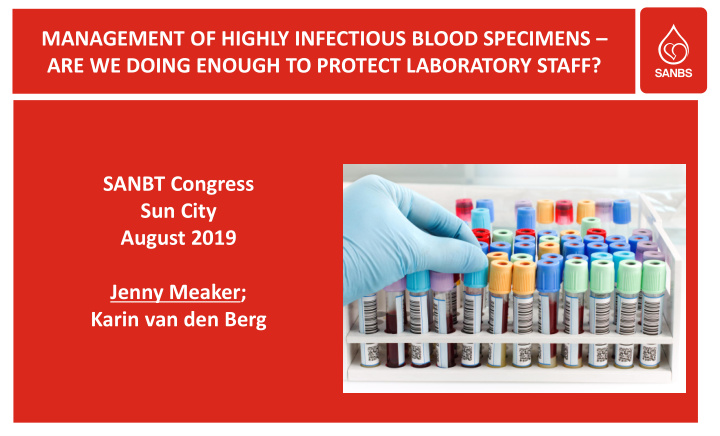



MANAGEMENT OF HIGHLY INFECTIOUS BLOOD SPECIMENS – ARE WE DOING ENOUGH TO PROTECT LABORATORY STAFF? SANBT Congress Sun City August 2019 Jenny Meaker; Karin van den Berg
Introduction • Viral Haemorrhagic Fevers (VHF) are highly contagious blood borne diseases associated with very high rates of morbidity and mortality. • Often presents with vague symptoms complicating early diagnosis. • Crossmatch requests are sometimes received in blood banks without full diagnostic information on the Blood Request Form (BRF), resulting in staff following routine crossmatch procedures.
Nature of The Problem • Specimens were sent by hospital doctors to the National Institute of Communicable Diseases (NICD) for confirmation of possible VHF, however, blood banks were not informed of the possible diagnosis. • Doctors and NICD operated independently, leaving SANBS out of the communication loop, thus placing staff at risk of exposure. • Doctor's used acronyms for the diagnosis on BRF that staff did not understand, e.g. ? CCHF / PUO / ?EB. • Some BRF had no diagnosis or perhaps just the ICD10 code for diagnosis.
Background Information • 2010 – SANBS Medical Director sent a letter to all hospitals titled ‘ VIRAL HAEMORRHAGIC FEVER CASES AND BLOOD TRANSFUSION’ requesting doctors to order Emergency Blood in suspected VHF cases. • 2013 – SANBS launched a project to raise awareness, reduce exposure and improve communications to alert relevant stakeholders of suspected cases. • Released the Management of Highly Infectious Specimens SOP • Conducted train-the-trainer of all blood bank supervisors (to train their staff) on VHF • Written communication was sent to all hospitals requesting detailed diagnostic information on blood request forms • But there were still gaps ….
VHF Task Team In November 2017, a Task Team was formed. The goals were to: • Improve communication amongst stakeholders • Prevent blood bank staff from crossmatching potential VHF specimens • Ensure doctors complete BRFs with the proper diagnosis and other relevant information Stakeholders of Task Team include: • Occupational Health • Medical Department (SANBS/WCBS) • Technical Department • NICD
Methods Used to Achieve Goals • A cascading (email and Whatsapp group ) communication system was established: – NICD notifies all parties as soon as a suspected VHF specimen is received – one of the Task Team members notifies the relevant blood bank – this prevents crossmatching procedures being performed • Systems within the blood banks, together with the existing procedure for managing VHF specimens, were reviewed and areas for improvement identified. • A database of suspected VHF cases was developed, recording patient details, e.g. admitting hospital, diagnosis indicated on BRF, etc.
Summary of Database on VHF Cases: November 2017 - 2019 No. Cases Cross Total Suspected Total Confirmed matched - prior to SUMMARY Cases report by % % Positive diagnosis NICD to Task Team confirmation 2017 6 3 50 % 1 16 % 2018 10 1 10 % 1 10 % 2019 6 3 50 % 0 0 TOTAL 22 7 31 % 2 9 %
Effectiveness of Task Team • Of the 22 suspected cases reported by the NICD: – 9 (40%) cases - no blood or blood products were ordered, but blood banks were alerted – 13 cases where blood products were ordered, • 8 (73%) did not indicate ‘suspected VHF’ as the diagnosis • 7 (31 %) were confirmed VHF positive. • Crossmatches were performed on 2 of these 7 cases: – one in 2017 indicated ‘?VHF’ as diagnosis on the requisition – one in 2018 indicated ‘Anaemia’ as the diagnosis on the requisition » Employees involved with these crossmatches were monitored according to the SANBS procedure as well as the infection control procedures of the source hospital. • Subsequent to these 2 cases, no crossmatches have been performed on potential VHF cases
Analysis of Blood Request Forms: FS/NC – June 2018 TOTAL NUMBER OF BRF ANALYSED: 321 35 10.9 % 123 38.32 % 50.78 % 1.25 % 163 6.85 % 4 22 NO DATES ANAEMIA NO DIAGNOSIS NO DOCTOR'S NAME SPECIMEN DRAWN BY NOT GIVEN
Conclusion and the Way Forward Did the Task Team meet their goals ? Communication system is effective and has raised awareness Identification of: • significant gap on the part of hospital doctors regarding the: • medico-legal requirement for completing the blood request forms in full • importance of safety to all staff involved with drawing specimens and crossmatching • use of Emergency Blood where possible • need for refresher training for blood bank staff • VHF and the associated risks for all involved • Information posters indicating acronyms for diseases, e.g. ? VHF / CCHF / PUO / EB etc.
Acknowledgements A big Thank You to the following: • NICD for their effective early warning notifications • The in-house ‘VHF Task Team’ for what they have brought to the safety of all blood bank staff • Bennie Koen and his technical team from FS/NC, for the assistance in gathering the info on the BRFs and all the other data • Imraan Kathree for his assistance in retrieving BRFs for analysis • My management team, Abbey Mothokoa and Alison Visagie for their support and encouragement
THANK YOU
Recommend
More recommend